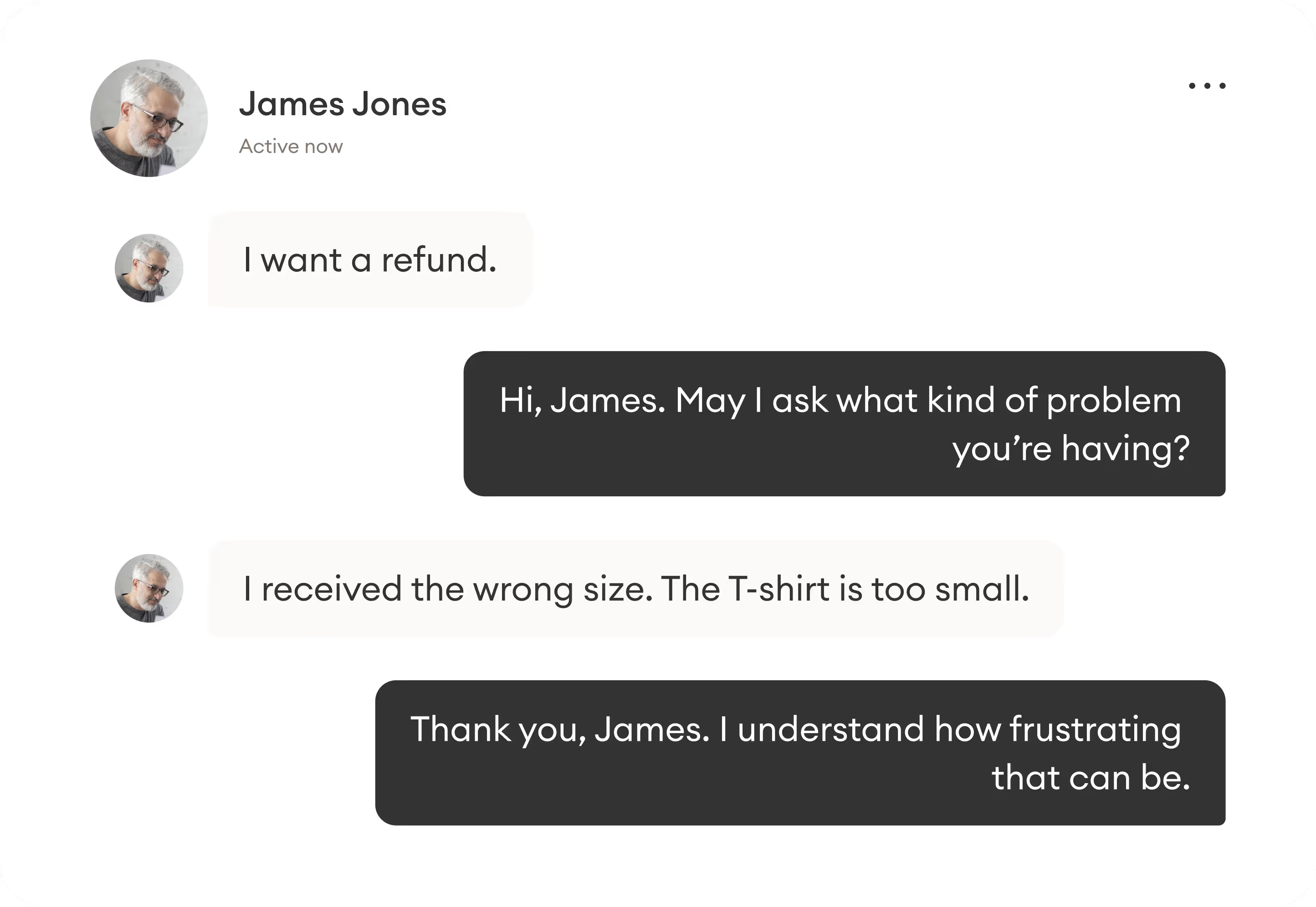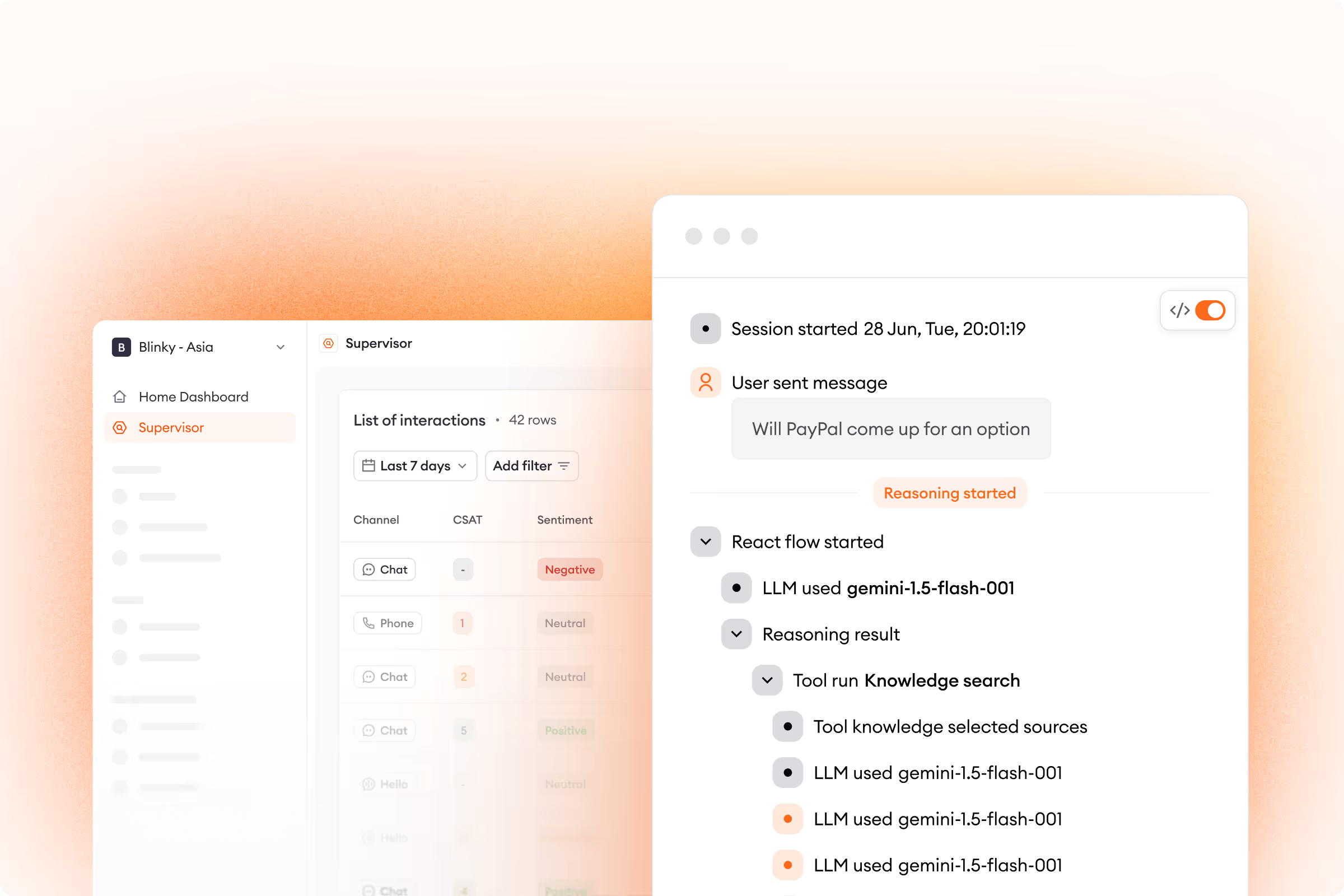They say three things in life are certain: death, taxes, and customer complaints.
And although no customer support team operates in a frustration-free bubble, complaints aren’t something to fear. Handling customer grievances the right way can make a world of difference. In fact, 83% of shoppers are more loyal to brands that actually respond to and resolve their complaints.
Excellent customer service isn’t about avoiding complaints altogether — it’s about taking care of them in a way that transforms a negative experience into a positive one.
Here are 11 effective tips on how to handle customer complaints.

Overcome your peak-season fears and learn how to empower every team member to deliver exceptional service in our on-demand webinar, How to Prepare Your Customer Service Team Ahead of Your Peak Season.
11 tips for handling customer complaints
1. Empathize
From the get-go, it’s important to build an emotional connection with unhappy customers. Remain calm, and try to see things from their point of view. Not only will this lead to deeper customer relationships, but it’ll help you defuse tense situations and make it easier to find suitable solutions.
Respond with reaffirming statements like I understand where you’re coming from so customers have no doubt you’re on their side. Also, ask clarifying questions such as Could you please elaborate so I have more context? to ensure you know exactly what needs to be done.

2. Personalize
With any customer conversation, it’s vital to make shoppers feel like an individual, not just another number. Keep your messages conversational so customers know they’re not being fed a scripted response. This level of personalization helps customers feel valued and heard, resulting in increased customer satisfaction and loyalty.
To customize your responses, address customers by name and repeat their issue in your own words to underscore you understand their unique case and are asking the right questions. For instance, a support agent can respond with Thanks, Mike. I understand it’s been 2 weeks since you ordered your Nike sneakers, and they still haven’t arrived. Is that correct?
To find out all the other ways you can personalize your customer service — and the benefits personalization brings — check out our What Is Personalized Customer Service? blog post.
3. Identify what types of customers you’re interacting with
One vital tactic to employ when handling customer complaints is finding out what types of shoppers you’re dealing with. Each buyer is motivated by different needs or attitudes, and pinpointing who you’re dealing with can go a long way in offering the appropriate support.
For example, new customers might have more straightforward complaints, so making a good first impression with simple replies is key. In contrast, repeat customers may be much more familiar with your products, so responding in greater detail and routing them to their preferred agents can help turn them into brand advocates.
Apart from customers, you also have the ability to group complaints into different categories. Once you know what kind of issue your customer has (damaged item, shipping problem, wrong size, etc.), you’ll be able to start the conversation — and find a solution — much faster.
4. Listen to feedback
Your past customer interactions can help you handle future complaints more effectively.
How?
It’s all about acting on customer feedback. Post-chat surveys are a great way to find out what you’re doing well and what needs improvement. Based on what customers say, you’ll be able to find the root causes of customer issues and finetune responses to better serve future customers.
Don’t shun negative feedback — turn it into a fundamental part of your complaint management strategy.

5. Log and track complaints
Customer complaints shouldn’t be treated as isolated incidents. By keeping a log of what’s frustrating your shoppers, you’ll be able to pick up on trends and improve how you handle future complaints.
So, you get an occasional complaint about your checkout process.You probably don’t need to worry about it.
But what if your team is getting 20 tickets a week about incorrect sizing? Then, you should flag this as a high-priority issue and notify the appropriate department to guarantee the information available to customers is updated immediately.
6. Respond quickly
60% of customers say long wait times are the most frustrating part of the customer service experience. If your support reps aren’t able to respond to shoppers and resolve tickets fast enough, you’ll likely continue seeing more and more complaints.
Exceed customer expectations by bringing response and resolution times to a minimum. When it comes to first response times, modern benchmarks sit at 1 hour or less for email and social media.
Answers over live chat should be instant. To consistently deliver immediate responses, consider a self-service chatbot that can fully resolve tickets without human interaction. This improves first response times and help cut down on your overall number of tickets by resolving them without involving an agent.
7. Be proactive
Traditional customer support is reactive, meaning service reps have to wait for customers to file a complaint before stepping in with assistance. But agents can be empowered to offer proactive support, reaching out to customers and possibly resolving issues before a ticket ever gets created. Proactively pinging customers highlights that you’re solution-oriented and prevents small inconveniences from becoming major headaches.
For instance, if you see that a shopper has browsed your website for a while without moving to checkout, shoot them a friendly message on your chat widget:
Hi there! Are you stuck trying to find the perfect product? Let me know what you’re looking for, and I’ll gladly offer some advice.
With proactive chat, customers who might otherwise grow irritated due to a lack of info on a given product page know a team member is there to answer any questions.
Discover how to implement proactive customer service in our blog post, Reactive vs Proactive Customer Service and How to Use Both.
8. Stay positive
Let’s be realistic — sometimes, it’s impossible to fully resolve a support ticket in the blink of an eye. But that doesn’t mean you have to throw your hands up in defeat. By conveying a positive attitude, you can still turn dissatisfied shoppers into happy ones, even when you can’t provide a solution right away.
This can be achieved by keeping negative statements like I can’t or That’s not possible out of your replies. Instead of apologizing with I’m sorry, it’s not possible to purchase that item. It is out of stock, say I’ll notify you as soon as that item is available again.
PRO TIP: To practice handling customer complaints, roleplay with generative AI. Prompt ChatGPT to act like an upset customer or a customer support rep (you can take turns), and see how your responses are received. The AI might even give you some original responses for you to try out in the real world.
9. Know when to escalate
Customer service representatives have many resources for answering customer questions: a knowledge base, product catalog, past conversations, etc. But one resource that’s easy to overlook is the rest of your support team.
Knowing when to hand tickets over to fellow agents or managers can be the difference between a loyal customer and a lost opportunity. If an angry customer asks a question that genuinely stumps you or is only growing more frustrated, you don’t have to waste their time — and yours.
Transfer the ticket to a manager or agent specializing in the relevant area to show shoppers your whole customer service team is committed to finding a fitting solution. To minimize resolution time, remember to provide whoever receives the ticket access to the entire conversation, the proper context, and any necessary resources.

10. Follow up when possible
Maybe you’ve successfully resolved a dissatisfied customer’s problem, but you’re still unsure if they walked away with a smile. Erase any doubt by triggering post-ticket workflows, like sending follow-up emails, that show shoppers you’re committed to bringing them a positive customer experience.
Let’s say a customer complained about receiving the wrong product. After offering to resend the original product free of charge, schedule an email to go out after delivery to double-check that everything’s all right. Better yet, go the extra mile and offer an exclusive discount in your email to entice customers to come back for more.
11. Use technology to your advantage
Previously, agents needed to handle many of the above items manually. Staying on top of customer complaints was time-consuming and tedious work. Today, however, AI-powered automation tools streamline many of these processes, empowering support agents to handle customer complaints more efficiently.
For instance, today’s leading solutions can deliver a shopper’s chat history to an agent’s screen in a single click, making it easier to provide answers curated to each customer’s needs. In addition, customer service platforms can automatically process complaints, make replies more empathetic, and build complex workflows.
Discover how Zowie’s customer service automation software helps agents efficiently handle more support tickets by booking a free demo today.
Templates for handling customer complaints
Customer service agents can save loads of time by using templates to address their most common customer complaints. By employing canned responses based on info from your FAQ page and knowledge base, support reps will have more freedom to jump in on more complex cases that require their expertise. With more bandwidth and less pressure, agents are able to give higher-quality answers across the board.
Here are suggested responses to 5 of the most common complaints ecommerce brands receive. Save them for your own use by downloading the document linked here.
1. “Checkout is too complicated.”
Hi [name],
I’m sorry to hear that. Would you mind telling me what parts of the process you’re having trouble with?
WAIT FOR REPLY
[name], I understand. If you’d like, I can walk you through the process now.
WAIT FOR REPLY
[name], I appreciate your patience today. I hope I was able to help.
2. “Shipping is taking too long.”
Hi [name],
Let me contact the courier to see the current order status. May I have your order number?
WAIT FOR REPLY
Thank you. According to the courier, your order will arrive on [date]. I sent in a request to expedite shipping. You can track your order here. Is there anything else I can help with?
WAIT FOR REPLY
Thanks for bearing with us, [name]. As a token of our appreciation, here’s a special offer for your next order: enter the promo code [code] and receive [discount/offer].
3. “I received a faulty product.”
Hi [name],
Could you explain what specifically seems to be the problem?
WAIT FOR REPLY
Thank you. Would you like me to send a replacement item? I can place that order with expedited shipping.
WAIT FOR REPLY
Great. Your new order should arrive on [date]. How does that sound?
4. “I received the wrong order.”
Hi [name],
Could you please explain what’s wrong with the order (wrong size, wrong color, different product, etc.)?
WAIT FOR REPLY
Thank you. Would you like to return your package for a a full refund or have us resend you the original order?
WAIT FOR REPLY
I’ll take care of that right away. I appreciate your patience, [name].
5. “I’m not satisfied with your products and want to cancel my subscription.”
Hi [name],
I’m sorry our products failed to meet your expectations. Could you please tell me what the specific problem is?
WAIT FOR REPLY
Thank your for sharing, [name]. Here’s the link to cancel, but I’d like to ask if there’s anything I can do to change your mind. Perhaps you’d like to show you some of our other subscription packages?
WAIT FOR REPLY
I understand. Thank you for your time, [name]. Please let me know if there’s anything else I can help you with.
Handle complaints more effectively with generative AI
Recent breakthroughs in generative AI mean much of the complaint handling process can be automated. With the right tools, you can improve response times without harming the customer experience.
By leveraging AI, solutions like Zowie help you prepare unique replies that have the exact tone, style, and length you’re looking for, ensuring shoppers get fast, accurate responses that still have a personal touch.

.avif)







